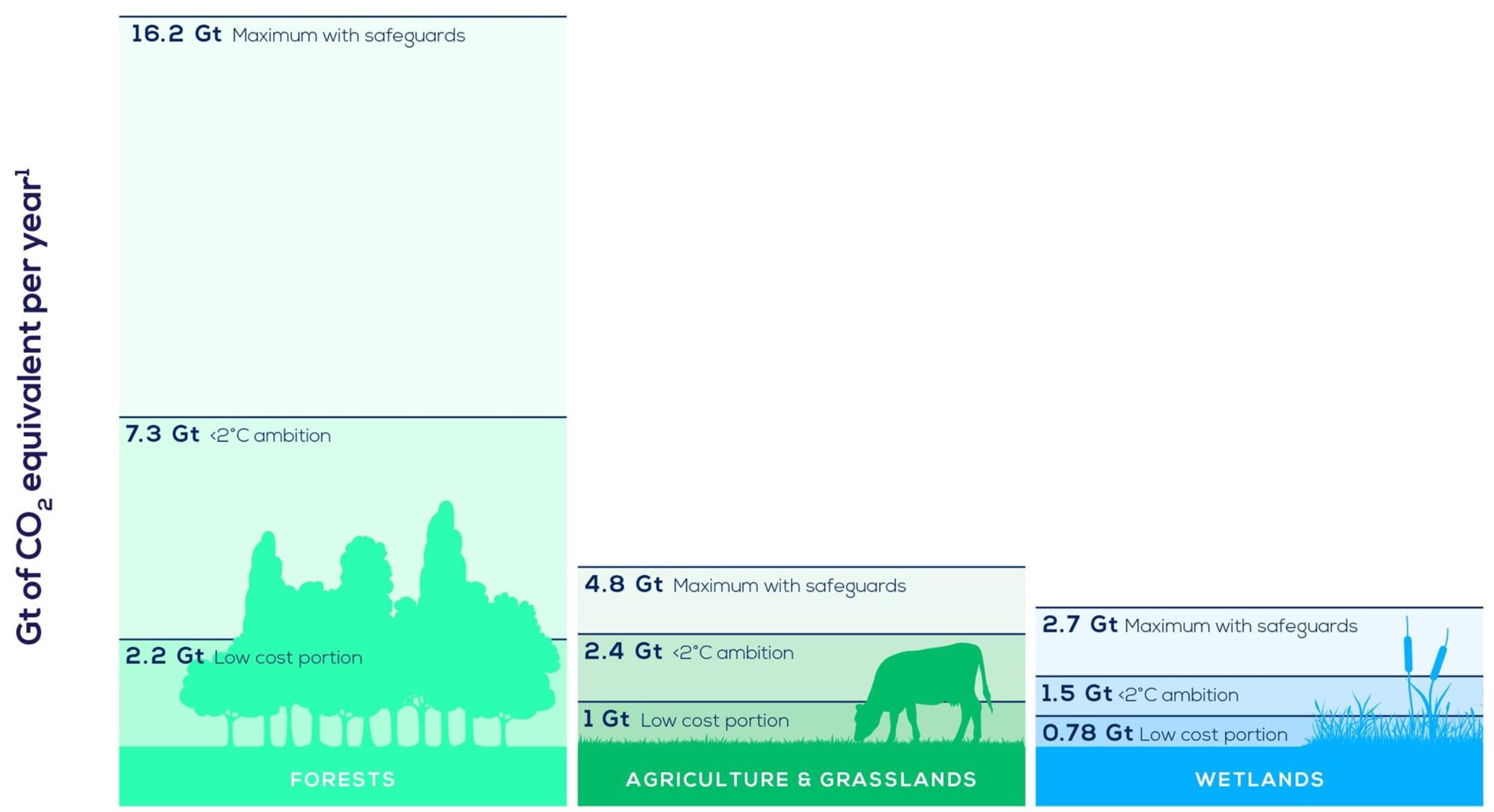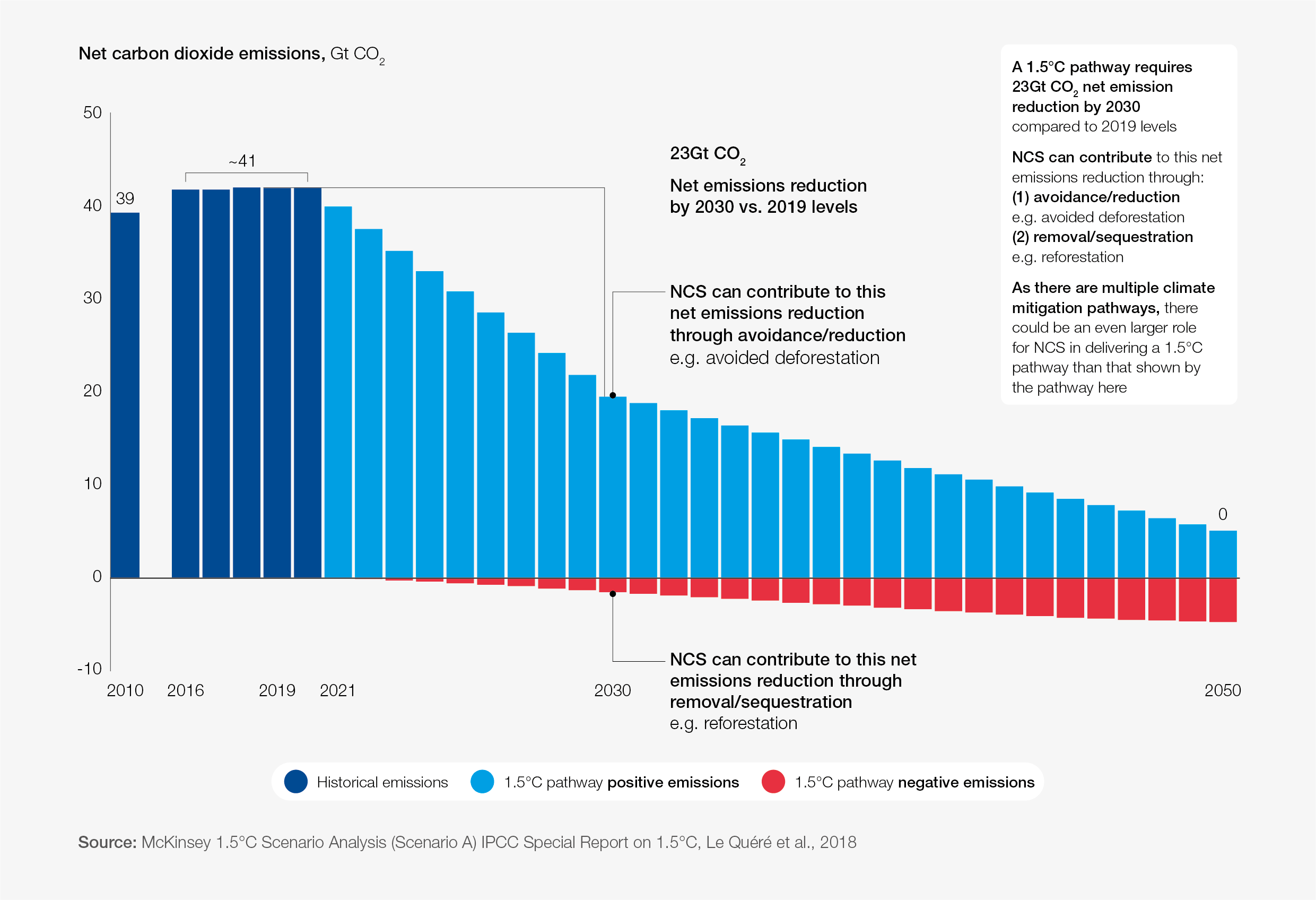Why natural climate solutions are about much more than carbon

The California forest carbon offset protocol requires that native species be used for reforestation. This conserves the environment and offsets carbon emissions.
Image: Fern M. Lomibao on Unsplash
Stay up to date:
SDG 13: Climate Action
- How we use land will be doubly important over the next decade: not only in reducing carbon emissions, but also in offsetting emissions from other sectors.
- Natural Climate Solutions (NCS) are activities that bring carbon reduction together with other benefits such as biodiversity, land restoration and support for rural and indigenous communities.
- The world needs to integrate conservation, restoration and sustainable production systems into a wider value system, rather than simply focusing on carbon offsets.
The Intergovernmental Panel on Climate Change reports that 23% of greenhouse gas emissions come from land use and land-use change. Any credible pathway to net-zero must include ending deforestation and the degradation of natural ecosystems plus reducing emissions associated with agricultural production and food systems. In fact, most net-zero scenarios include significant “removals” of CO2 from the atmosphere via reforestation and ecosystem restoration.
The way we use land will be doubly important over the next decade; not only because it has an impact on greenhouse gas emissions, but also because we need to offset emissions from sectors in which carbon reduction is more difficult and requires long-term technological transformation. The task of transforming the energy and land-use sectors in tandem will require supportive economic and social policy frameworks.
Policies to reform land use for environmental reasons may also help to achieve other sustainable development and biodiversity goals. Any climate finance in this sector needs to be designed to deliver benefits not only to the climate, but also to the conservation of nature, and to the economic, cultural, and spiritual requirements of human society.
Natural Climate Solutions
Natural Climate Solutions (NCS) include activities around nature conservation, the restoration of degraded land, and the sustainable management of agriculture and forestry production systems. While climate benefits are calculated in tonnes of carbon dioxide equivalent, investments in NCS generate additional benefits – known as 'co-benefits –such as biodiversity conservation and enhancement, fresh water regulation and social and economic support to rural and indigenous communities.
They support adaptation to climate change and mitigate emissions. For example, agroforestry systems can create more resilient farming economies, restoration projects can reduce the impacts of intense rainfall events and floods, and the re-introduction of traditional burning regimes can reduce the risk of catastrophic wildfire.
One of the debates about carbon offsets is how to value these co-benefits. Simple carbon accounting may not fully recognise the additional contribution being made by NCS activities. It may also lead to simplified projects, like high productivity monoculture timber plantations, becoming the dominant type of NCS project. While timber plantations are relatively easy to measure and monitor from a climate perspective and may contribute economic benefits, they do not bring the same biodiversity benefits as restoring natural ecosystems.
The major regulated carbon markets are beginning to recognize this and create mechanisms to enhance nature-oriented outcomes alongside decarbonisation outcomes. The California forest carbon offset protocol for reforestation projects requires that native species be used. This has led to substantial conservation outcomes— for example, New Forests has developed projects with the Yurok Tribe that helped them recover traditional lands in coastal California. In Alaska, New Forests has worked with the Chugach to conserve large-scale salmon habitat.
In Australia, the government has launched a pilot scheme in which natural restoration plantings can both be accredited under the country’s Emissions Reduction Fund and bid into a pilot biodiversity payment scheme. New Zealand is currently working on policies that will make reforestation with natural species competitive through the establishment of permanent exotic pine plantations. It may be possible to apply some of these innovations in other regions, too.

In the voluntary carbon market, project types like REDD+ encompass biodiversity conservation because they are targeted at reducing the destruction of natural forests. A significant proportion of the voluntary market is based on projects in tropical, developing nations. To be credible, these projects need to make a positive contribution to communities and to conservation. Pricing also needs to reflect the importance and value of these co-benefits, so that the outcomes can be monitored and maintained into the future. Paying $3 to $4 per tonne will not reflect the commitment and needs associated with implementing and maintaining these projects.
Additional community development and investment may be necessary to maintain the progress made as a result of these activities. New Forests has been investing in Southeast Asia and the Pacific for more than a decade, and most investments need to ensure community engagement, education and economic opportunities, as well as fire exclusion, wildlife conservation and protection of high conservation value areas. To justify the higher prices for these complex voluntary offsets, the production systems need to be adequately certified and broader impact metrics need to be successfully tracked.
However, carbon markets are not going to be the only way to deliver biodiversity and sustainable development outcomes. Natural Capital Accounting is also gaining momentum. Under this system, companies may quantify the value of natural assets or define liabilities associated with emissions or impacts on nature. Any natural capital balance sheet should be aiming to be net-positive. This could mean that we can put a value on both carbon positive assets and the conservation and restoration of nature.
What is the World Economic Forum doing on natural climate solutions?
Fintech companies have developed new tools, including the tokenization of rights and sponsorship of nature, distributed ledger technologies for efficiently tracking ownership and transactions, and automated tracking of carbon stocks and biodiversity values. These could create integrated approaches to natural capital accounting and corporate natural capital balance sheets. There are also new technologies to help even small landowners earn money for conservation and restoration projects, with highly efficient monitoring systems reducing transaction costs.
The world needs to integrate conservation, restoration and sustainable production systems into a wider value system, rather than simply focusing on carbon offsets. It is inevitable that as the global economy expands, and the pressure on nature rises, the world will ultimately need to reach a position in which conservation and production systems are appropriately balanced, and rural economies can attract sustainable investment, thrive and be part of conserving the most important asset—the biosphere.
Don't miss any update on this topic
Create a free account and access your personalized content collection with our latest publications and analyses.
License and Republishing
World Economic Forum articles may be republished in accordance with the Creative Commons Attribution-NonCommercial-NoDerivatives 4.0 International Public License, and in accordance with our Terms of Use.
The views expressed in this article are those of the author alone and not the World Economic Forum.
Related topics:
Forum Stories newsletter
Bringing you weekly curated insights and analysis on the global issues that matter.
More on Climate ActionSee all
Andrea Willige
July 30, 2025
Tom Crowfoot
July 30, 2025
Tom Crowfoot
July 30, 2025
Wee Kean Fong and Yvonne Zhou
July 29, 2025
Pranidhi Sawhney and Adam Skali
July 29, 2025






